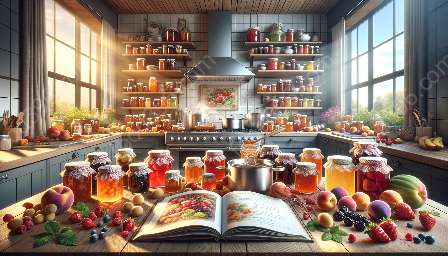Are you passionate about making your own jams and jellies to preserve the flavors of the season? Jam and jelly making is a wonderful way to enjoy the bounties of nature throughout the year. However, there can be some common issues that arise during the process, such as setting problems, texture issues, or fruit separation. Understanding how to troubleshoot these problems will help you achieve consistent and delicious results every time. In this topic cluster, we will explore the most common issues that can occur during jam and jelly making and provide practical solutions to ensure success.
Setting Problems
One of the most common issues in jam and jelly making is encountering problems with the setting of the preserves. A common indicator of this issue is when the jam or jelly does not firm up properly after cooling. There are several potential causes for setting problems, and understanding these causes is crucial for troubleshooting and resolving the issue.
Causes
- Pectin levels: Insufficient pectin in the fruit or added pectin can lead to setting problems. Some fruits naturally have lower pectin levels, requiring the addition of commercial pectin to achieve proper setting.
- Undercooking: Inadequate cooking time can result in a lack of proper setting. It is essential to follow the recommended cooking times and test for setting using the wrinkle test or thermometer.
- Overcooking: On the other hand, overcooking can also lead to setting problems, as prolonged cooking can degrade the pectin and result in a runny texture.
- Acid and Sugar Levels: Incorrect acid or sugar levels can interfere with the gelling process, affecting the setting of the preserves.
Solutions
To address setting problems, consider the following solutions:
- Adjust pectin levels: Ensure that fruits with low pectin content receive the appropriate amount of added pectin. Follow recipes and use reliable sources for pectin recommendations.
- Monitor cooking time: Use a thermometer or conduct the wrinkle test to determine the gel point accurately. Avoid undercooking or overcooking the preserves.
- Balance acid and sugar levels: Follow tested recipes to achieve the right balance of acid and sugar, crucial for successful setting.
Texture Issues
Texture problems, such as a grainy or rubbery consistency, can detract from the overall quality of jams and jellies. Understanding the causes of these texture issues and implementing the appropriate solutions can help you achieve a smooth and pleasing texture in your preserves.
Causes
- Crystallization: Improper sugar dissolving, rapid cooling, or excessive stirring during cooking can lead to crystallization, resulting in a grainy texture.
- Extended cooking: Prolonged cooking can cause the pectin to break down, resulting in a rubbery or tough texture.
- Improper fruit preparation: Inadequate crushing or mashing of fruits can lead to texture issues, as larger fruit pieces may not integrate well into the gel structure.
Solutions
To address texture issues in your jams and jellies, consider the following solutions:
- Proper sugar dissolution: Ensure that sugar is completely dissolved before reaching the gel point, and minimize stirring to prevent crystallization.
- Monitor cooking time: Avoid overcooking the preserves, as prolonged cooking can cause the pectin to break down, resulting in undesirable textures.
- Thorough fruit preparation: Properly crush or mash fruits to facilitate their integration into the gel structure, promoting a smoother texture.
Fruit Separation
When making preserves with chunky or whole fruit, encountering issues of fruit separation can be frustrating. Fruit separation can cause an uneven distribution of fruit in the jar, affecting both the appearance and taste of the preserves. Understanding the causes and solutions for fruit separation is essential for achieving well-integrated and visually appealing jams and jellies.
Causes
- Insufficient fruit preparation: Inadequate crushing or cooking process can result in unevenly distributed fruit, leading to separation.
- Improper jar filling: Incorrect methods of filling the jars can cause fruit to rise to the top, resulting in separation when the preserves cool and set.
Solutions
To address fruit separation issues, consider the following solutions:
- Thorough fruit preparation: Ensure that fruits are properly crushed or chopped to promote even distribution throughout the preserves.
- Proper jar filling: Use appropriate methods to fill the jars, such as layering the fruit and filling with syrup to minimize fruit rising to the top during cooling.
By understanding the potential issues that may arise during jam and jelly making and learning how to troubleshoot and resolve these problems, you can enhance your skills in food preservation and processing. With the right knowledge and techniques, you can consistently produce delicious, well-set, and visually appealing jams and jellies to enjoy and share with others.
Explore the wonderful world of jam and jelly making, and discover the joy of creating your own flavorful preserves that capture the essence of each season.
Happy preserving!

